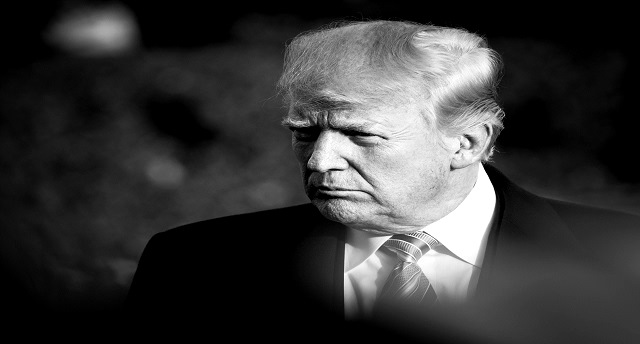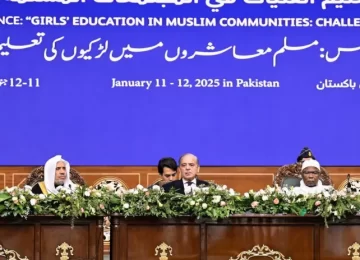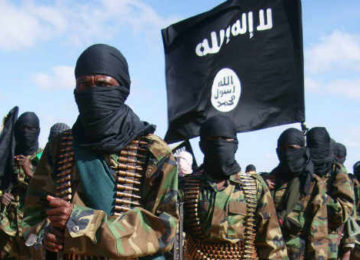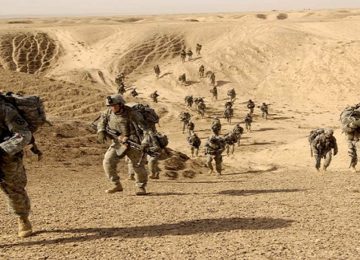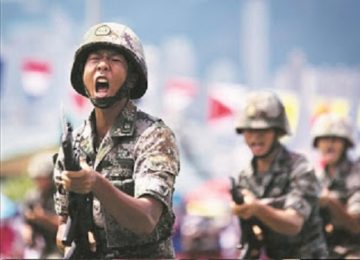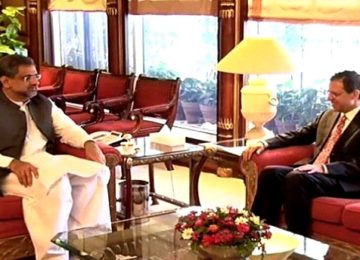January 16, 2018
By Sitwat Waqar Bokhari
Using political options for resolution of the Afghan conflict is the only way forward for the US, though if that is really the mission that the US has embarked on.
It appears that Trump’s Afghan plan may not be one that involves defeating terrorism and restoring peace and stability in Afghanistan; but perhaps perpetuating instability in the war-torn country to contain the ambitious expansion of Chinese economic interests or, Russian influence, for that matter, and maintain its foothold in South Asia. As the talk of China-Pakistan Economic Corridor’s prosperous prospects connecting the region through transit and trade increased, so did US’s Afghan plan tilt towards blaming and defaming China’s South Asian OBOR partner, Pakistan; whose officials continue to remind the US time and again of its enormous sacrifices in the US-led war on terror. Pakistan’s efforts in the fight against terrorism have been reaffirmed by Chinese government, and are manifested in the loss of 70,000 Pakistanis in the US-led war against terrorism since 2001.
However, the US has completely turned a blind eye to Pakistan’s counter-terrorism efforts and seemingly embarked on a mission to hurl unfounded allegations at the former; perhaps to divert the world’s attention from its own failures in the 17 year long war in Afghanistan. The barrage of USA’s anti-Pakistan diatribe peaked when President Trump began the New Year with an aggressive tweet aimed at Pakistan, reiterating US accusation of the latter providing “safe haven to the terrorists we [the US] hunt[s]” and claiming that “the United States has foolishly given Pakistan more than 33 billion dollars in aid over the last 15 years, and they [Pakistan] have given us nothing but lies & deceit.” The verbal assault continued, culminating in threats to withhold half of the $700 million disbursement to Pakistan for its deployment of forces along Pak-Afghan border.
While Pakistan’s response to these threats has been fairly nonchalant and measured, Trump’s reinforced allegations point one in the direction of USA’s own incompetence in concluding the war it began in 2001. Far from achieving any gains, Trump’s first year in office only witnessed an escalation in terrorist attacks occurring in Afghanistan, with ISKP (also known as Daesh), dominating headlines and claiming some of the deadliest attacks across the already war-ravaged country. Amnesty International South Asia Director Biraj Patnaik has termed the year 2017 as one of the deadliest years on record in the country; while, in six different major attacks across Kabul and Herat alone, Daesh claimed the lives of 163 civilians and wounded 264. October 2017 particularly stood out as the bloodiest month in over a decade of terrorism in Afghanistan, accounting for 269 deaths of Afghan military and civilians from violence claimed both by Daesh as well as Taliban in some of the most high-profile terrorist attacks.
Clearly, Trump’s geared up aggressive military strategy for Afghanistan with its upsurge in American troops stationed in Afghanistan, now numbering at 14,000, seems to have met a dead end at the end of its 17 years of war against the Taliban. Despite Trump’s accelerated air war along with CIA’s expansion in the US mission in Afghanistan, and the US dropping of the 11-ton bomb, called the ‘Mother of all Bombs’, in eastern Afghanistan earlier in April 2017, Afghanistan has only experienced a 50 percent rise in civilian casualties in 2017, as compared to 2016, as reported by the United Nations in October 2017. In September alone, the US dropped more than 2,400 bombs on Afghanistan, while during the same period in 2016, it had dropped 1,337.
With 2017 being termed as a banner year for the US arms industry, with annual revenues for American arms companies amounting to a $364.8 billion, and Trump’s exponential increase in the number of airstrikes over Afghanistan, one would assume Daesh would have been diminished to a 1/3rd; However, UNAMA’s special report released in November 2017, noted a persistent pattern of attacks, mostly targeting Shia places of worship, continuing unabated between January 2016 and November 2017, causing 689 civilian casualties (230 killed, 459 injured) in 12 documented attacks; 8 of which ISKP publically claimed through the Islamic State-affiliated Al Amaq news agency. Four of these 12 incidents took place in 2016 while eight occurred in the first 10 months of 2017 under Trump’s administration.
The resilience of Daesh particularly manifested even more alarmingly in Afghanistan when on December 18, ISKP’s heavily armed militants managed to attack Afghan spy agency NDS facility right in the heart of the Kabul city. Surprisingly, some of these ISKP’s attacks came within few metres of embassies and NATO’s Resolute Support mission which now raises eyebrows at the efficacy regarding vows by head of Forces-Afghanistan General, John Nicholson to “hunt them down” until they are “annihilated”. Certainly, the inability of the thousands of US troops deployed in Afghanistan to curb the expansion of the outfit, despite the accelerated aerial war, gives birth to suspicions surrounding US’ own commitment in eliminating terrorism from the war torn country. Furthermore, Daesh’s capability to expand right under the nose of highly trained US forces has raised fears that Afghanistan could become a new base for IS fighters fleeing the battlefields of Syria and Iraq, where the group has lost swathes of territory.
However, for some it is not the inability of the US to fight Daesh, but perhaps, with the willful permission of the US that the group continues to proliferate and spread chaos in the region. In November 2017, in an exclusive interview with Al Jazeera, former Afghan President Hamid Karzai claimed that the US was itself willingly allowing the ISIS to flourish in Afghanistan. The suspicions regarding the reality of this notion appeared to be seeming stronger when the ISKP accelerated its attacks towards the end of 2017, with Russian media quoting Russia’s special presidential envoy for Afghanistan Zamir Kabulov in December 2017 as saying that there were about 10,000 Islamic State militants in Afghanistan whose number was growing as fighters, that fled Syria and Iraq, were heading to the war-ravaged country of Afghanistan. The Russian envoy alleged helicopters “without identifying insignia” to be transferring fighters and delivering “Western [military] equipment” to the Afghan branch of the ISKP. Earlier in July 2017, the Pentagon had claimed that ISIS-K was down to about 1,000 fightersacross Afghanistan, from a high of 2,500 in 2015; though, Afghan intelligence differed, stating that there were more than 1,000 alone in Achin district at the time.
Interestingly, one would imagine if Pakistan has indeed been supporting these terrorist groups against US troops as alleged, the casualty figure of the US would be high. Instead, to anyone’s surprise, in 2017, only 15 US soldiers have reportedly died in Afghanistan, 11 of whom were killed in combat. Compared to past years, the number of US military fatalities in Afghanistan in 2017 is not particularly high – only 10 were killed in combat in Afghanistan in 2016. In comparison, Pakistan has lost hundreds of its armed personnel in the war against terrorism in 2017 alone. In fact, since the US invaded Afghanistan in 2001 following the 9/11 attacks, 2,400 US troops were killed as compared to Pakistan’s 7,000 personnel of the armed forces in the fight against terrorism; not to mention, the negative financial impact of the war for Pakistan exceeded $123 billion.
In an interview with Royal United Services Institute (RUSI), former US military commander Gen (R) David Patraeus, has dismissed US allegations against Pakistan as unfounded on actual facts on ground. Regarding his association with his Pakistani counterparts and interaction with ISI as head of CIA, he stated, he could never find a convincing piece of evidence which supported the alleged double game by Pakistan’s intelligence agency, ISI, or its explicit support to elements associated with terrorism. Coming from a former head of US spy agency, this claim debunks US accusations of Pakistan playing a double game and supporting Taliban in the Pashtun tribal areas of Afghanistan-Pakistan border.
Instead, it is pertinent to note here that ISKP’s presence in Afghanistan has also threatened the security of Pakistan, as over the past one year the group claimed responsibility for as many as six deadliest attacks, in which 153 were killed. This has been claimed in “Pakistan Security Report 2017” released by a think-tank, Pakistan Institute for Peace Studies (PIPS), which has identified the attacks to have targeted the convoy of Senate Deputy Chairman Abdul Ghafoor Haideri, Sehwan shrine, Shah Noorani shrine in Lasbela, Bethel Memorial Methodist Church in Quetta and Dargah Pir Rakhyal Shah in Fatehpur area of Jhal Magsi district and the abduction and killing of two Chinese nationals.
It appears that it ought to be Pakistan that should be complaining about the expansion of terrorism in Afghanistan, and is, hence, valid in its need for fencing the porous frontier dividing Afghanistan and Pakistan to prevent the infiltration of terrorists into its territory. As shown in PIPS’ 2017 security report, attacks in Pakistan from across Afghan and Indian borders in 2017 also witnessed a significant surge – at 131percent, numbering at 171 and claiming the lives of 188 while leaving 348 people injured. It is ironic that the US with its accusations against Pakistan of harboring terrorists wasn’t the one to initiate the idea of fencing the Pak-Afghan border, but Pakistan itself, which has been suffering from terrorism economically and socially and has to be the one to bear the cost in its desperation of curbing terrorism.
Certainly, as former US Ambassador to Pakistan Richard G Olson warned his country, Donald Trump’s attempts at “humiliating and penalising” Pakistan for allegedly failing to take decisive action against militant groups hostile to the US are unlikely to work and that Islamabad has greater leverage over Washington than is usually perceived. Washington’s freeze on aid, which fell to $750 million in 2017, to Pakistan in military assistance for US-led war against terror will only have limited impact on Pakistan, due to its strengthening alliance with China and the diminishing importance of aid to Pakistan’s economy in the face of the more lucrative prospects of CPEC. With CPEC’s progress, Pakistan may perfectly do without foreign aid at all. This is certainly one reason why India, which shares similar US interests of containing China’s economic expansion, “very strongly” expressed its opposition to the $46 billion project of CPEC to pass through Pakistan-occupied Kashmir, calling it not only “unacceptable” but alongside continuing all Indian efforts, in Afghanistan and elsewhere, to brand its western neighbor a terrorist state.
Sitwat Waqar Bokhari is a Programme Consultant for Afghan Studies Center at CRSS
© Center for Research and Security Studies (CRSS) and Afghan Studies Center (ASC), Islamabad.



